Learn how to write a SOP for Environment Monitoring Procedure in Pharmaceuticals, including acceptance criteria for temperature, humidity, and microbial counts.
1. PURPOSE
To describes a procedure for monitoring the environmental conditions in pharmaceutical manufacturing and storage areas to ensure compliance with regulatory standards and maintain product quality.
2. SCOPE
This SOP is applicable for monitoring environmental parameters in controlled areas such as cleanrooms, production, and storage facilities in compliance with regulatory guidelines.
3. RESPONSIBILITY
3.1 Quality Control personnel are responsible to conduct environmental monitoring as per schedule and Analyze and document results.
3.2 Quality Assurancepersonnel are responsible to review and approve monitoring data.
3.3 Productionpersonnel are responsible to ensure the environment remains within the defined parameters during production activities. They are also responsible to notify QC/QA teams of deviations.
3.4 Engineering/Maintenancepersonnel are responsible to ensure proper functioning of HVAC, air filtration, and related systems.
4. ACCOUNTABILITY
Head of the Quality Assurance Department
5. ASSOCIATED DOCUMENTS / REFERENCES
5.1 EU GMP Annex 1
5.2 ISO 14644-1: Cleanroom Standards
5.3 USP <797>: Environmental Monitoring
6. PRECAUTIONS
6.1 Use appropriate Personal Protective Equipment (PPE), including gloves, lab coat, and safety goggles.
6.2 Ensure all reagents and samples are disposed of according to lab guidelines.
7. PROCEDURE
7.1 Materials and Equipment
7.1.1 Air samplers
7.1.2 Settle plates (agar plates)
7.1.3 Swabs Equipment’s
7.1.4 Particle counters
7.1.5 Temperature and humidity loggers
7.1.6 Personal Protective Equipment (PPE)
7.2 Monitoring Devices
7.2.1 To monitor temperature and humidity use calibrated data loggers or Thermo hygrometers.
7.2.2 For Air Sampling uses active air samplers or settle plates.
7.2.3 For sampling of surface use contact plates or swabs.
7.3 Monitoring Frequency
7.3.1 Temperature and Humidity: Continuous monitoring (data loggers); manual recording at least twice daily.
7.3.2 Microbial Counts: As per risk assessment or regulatory requirement:
Daily in critical areas.
Weekly/monthly in non-critical areas.
7.4 Acceptance Criteria
7.4.1 Temperature
7.4.1.1 Production Areas: 18°C to 25°C (specific limits may vary based on product requirements).
7.4.1.2 Storage Areas:
General: 15°C to 25°C
Refrigerated Storage: 2°C to 8°C
Freezer Storage: -25°C to -15°C
7.4.1.3 Deviation Handling: ±2°C tolerance before initiating corrective actions.
7.4.2 Humidity
7.4.2.1 Production Areas: 40% to 60% Relative Humidity (RH).
7.4.2.2 Storage Areas:
Non-hygroscopic products: ≤65% RH
Hygroscopic products: 35% to 45% RH
7.4.2.3 Deviation Handling: ±5% RH tolerance before initiating corrective actions.
7.4.3 Microbial Counts (Cleanrooms):
| Area Classification | Maximum Viable Count (CFU/m³) | Settle Plate (CFU/90mm Plate) | Surface Contact Plate (CFU/25cm²) |
| Grade A (Critical) | <1 | <1 | <1 |
| Grade B | ≤10 | ≤5 | ≤5 |
| Grade C | ≤100 | ≤50 | ≤25 |
| Grade D | ≤200 | ≤100 | ≤50 |
Note: Limits may vary based on regulatory guidelines (e.g., EU GMP Annex 1, ISO 14644-1).
7.5 Documentation
7.5.1 Record data in an Environmental Monitoring Logbook or an electronic system.
7.5.2 Investigate deviations promptly using a CAPA (Corrective and Preventive Action) system.
7.6 Calibration
7.6.1 Ensure all monitoring devices are calibrated annually or as per manufacturer recommendations.
7.7 Deviation Management
7.7.1 Temperature and Humidity: Investigate if values fall outside specified ranges.
7.7.2 Microbial Counts: Perform root cause analysis if counts exceed limits. Consider re-sanitizing the area and resampling.
8. DEFINITIONS AND ABBREVIATIONS
8.1 Environmental Monitoring (EM): The process of measuring physical and microbiological parameters of the environment to ensure compliance.
8.2 Critical Areas: Areas where product exposure to the environment occurs (e.g., aseptic zones, filling lines).
8.3 Non-Critical Areas: Areas not directly affecting product exposure but requiring controlled conditions (e.g., storage rooms).
8.4 CAPA: Corrective and Preventive Action
8.5 QC: Quality Control
8.6 PPE: Personal Protective Equipment
8.7 SOP: Standard Operating Procedure
8.8 ISO: International Organization for Standardization
8.9 RH: Relative Humidity
8.10 EU: European Union
8.11 USP: United States Pharmacopoeia
8.12 GMP: Good Manufacturing Practice
9. ANNEXES
9.1 Annex-1: Environment Monitoring Schedule
10. REVISION HISTORY
| Version | Date | Description of Change | Reviewed By | Approved By |
| 1.0 |
Read Also:
- SOP of SOP in Pharmaceutical
- SOP for Vendor Audit (Supplier Audit)
- SOP for Basic GMP Requirements in Production Area
- SOP for Annual Product Quality Reviews (APQR)
- SOP for Concurrent Process Validation
- SOP for Internal Audit
- SOP for Training Records
- SOP for Training and Evaluation of the Employee

Abdus Sobhan Salim is professional experienced pharmacist in pharmaceuticals, author and founder of pharmabossbd.com, the first Bangladeshi pharmaceutical blogger since 2019.



